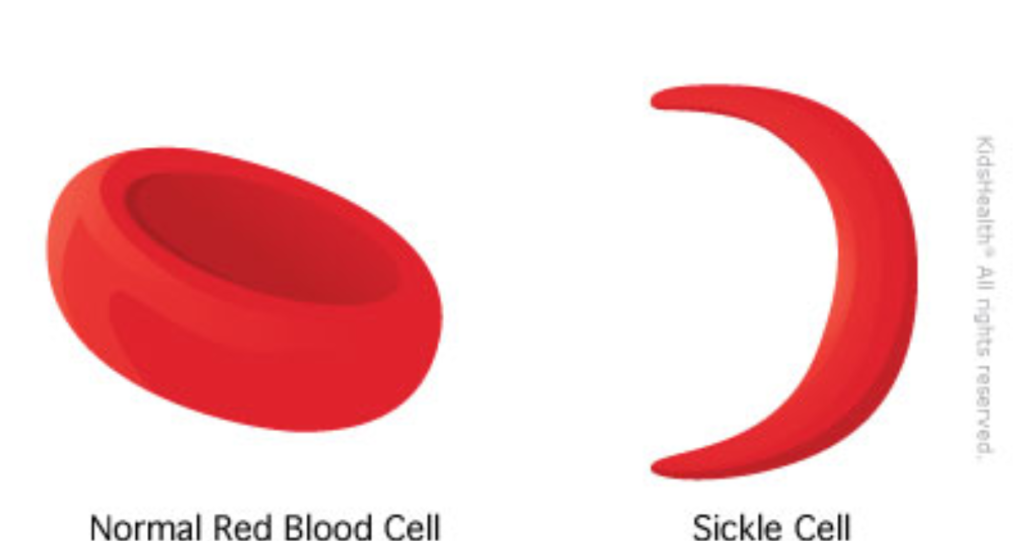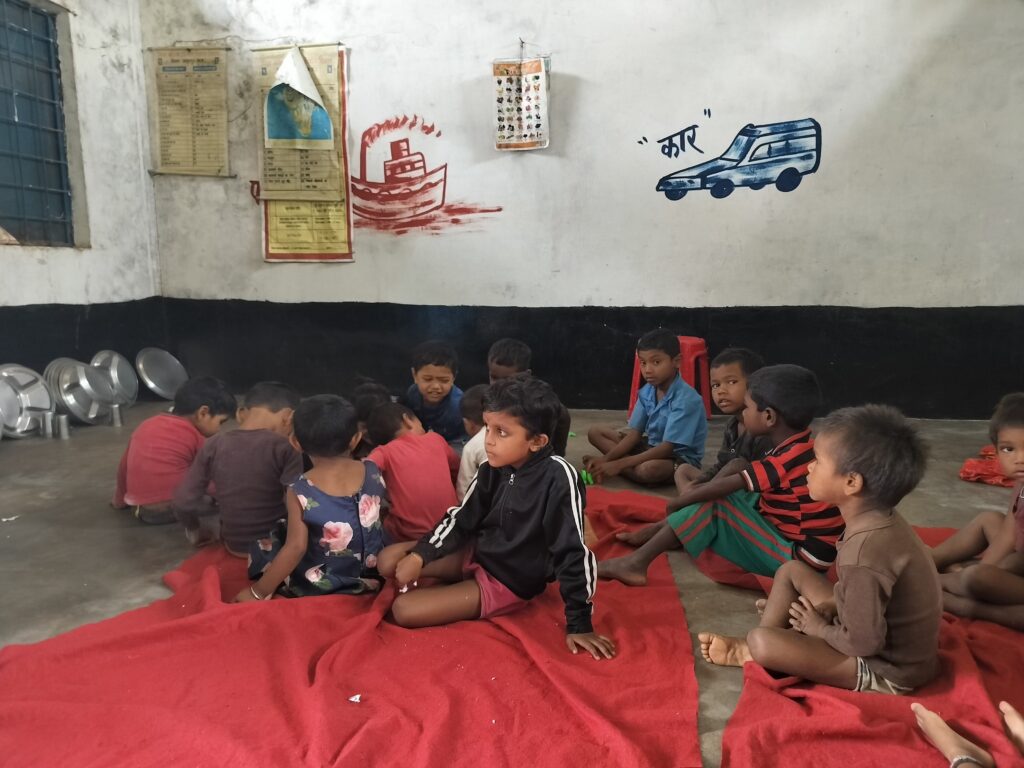On 8th August 2023, I accompanied Laxmi Patkar, a counsellor at Jan Swasthya Sahyog (JSS) to many villages in Jaithari block of Anuppur district, Madhya Pradesh. The purpose of the trip was to distribute sickle cell anemia test reports to parents of children who participated during the screenings that JSS had undertaken a few weeks ago.
What is Sickle Cell Anemia?
It is a genetic disorder. One can get the disease only through their parents. Worldwide, there is no cure for sickle cell disease yet. There is still no proof as to how this disease originated but it has been scientifically observed that it exists around the region where malaria is prevalant. It can affect anybody irrespective of their gender, caste, religion, race, financial and educational status and so on.
A normal blood cell is round in shape and its shelf life is 120 days. A sickle cell looks like half a moon or as the name suggests like a sickle (as shown in the image below) and its shelf life is only around 15-30 days. This results in poor blood circulation. The blood then has low amount of oxygen in it, resulting in chronic anemia.

How Is The Screening Conducted?
An ANM (Auxiliary Nurse Midwife), a lab technician and a resource person together conduct the screening. They collect a blood sample of the person. This test known as solubility test determines if a person is positive or negative within ten minutes. If positive, then the blood sample is further taken to a lab to perform another test. This further determines if the person is infected or a carrier.
An infected patient suffers from health issues and has to undergo the treatment. On the other hand, a carrier is fine and does not have to take the treatment. But if they marry another carrier or an infected person, then there are chances of their children getting sickle cell.
JSS has been working towards public health in Chhattisgarh for more than two decades. The team realized that the main cause of many health issues in the tribal belt across eastern Maharashtra, Chhattisgarh, Jharkhand and Madhya Pradesh is due to sickle cell anemia. Thus the need to tackle it came up. There was no diagnosis or treatment facility for sickle cell in government facilities here until in 2018 when JSS started working on it in Anuppur, Madhya Pradesh.
Baihar Village
I, with Laxmi, my colleague, left from office in the morning on her bike. 45 minutes away was Baihar village, our first stop. A girl there had tested positive for sickle cell. We informed her father, Ramdulhari*, about the test results and gave him all the information he needed about the disease. Laxmi advised him to visit Jaithari, the nearest public hospital, with the whole family in a couple of days. The purpose was to get them all screened, and collect medicines for the girl.

JSS organises PSGM (Patient Support Group Meetings) every month at Jaithari, Anuppur, Kotma and other districts nearby. In these meetings, both the old and new patients living around, come. The doctors check their weight, haemoglobin, counsel the patients and give monthly medicines free of cost.
I was worried if Ramdulhari doesn’t come or refuses to come, and asked Laxmi what to do if that happens. “We will take their blood for testing and screening with their consent. Similarly we will ask them to take medicines, to scree their family and to do regular check-ups. All we can do is provide them with the information and treatment. It is up to them to avail the services. There is no space for force here.”, she said.
The Baihar Saga Continues
Laxmi and I moved on to the next patient. Foolbai*, a school girl, hadn’t come to school that day and the teacher was kind enough to lead us to her home. When we saw the house empty, we started talking to neighbours. Foolbai was playing at one of her neighbour’s house who was also her aunt. Her parents were not in the village, so we spoke to her aunt and gave the same information as we gave to Ramdulhari. The aunt did not respond much and we left the house wondering if we would ever see Foolbai in the support group meeting.
In the same village, there was a boy who also tested positive for sickle cell and his house was empty too. The whole family had gone to get ration in the PDS (Public Distribution System). They call it ‘society’ here. We went there and asked the boy’s mother for 15 minutes of her time to talk about his health and treatment. Irrespective of the urgency and scarcity of time displayed by us, she asked us to wait until she gets her ration. We waited for her nearby at an Aanganwadi (rural child care centres). She came afterwards and my colleague did her job.

Kapriya Village
It was at noon when we reached a primary school where we had screened almost all the students. After distributing the negative reports to them, the teacher asked us if we could spare 15 minutes to educate the children about sickle cell anemia and other diseases that prevail during monsoon. Everyone excitedly gathered around us to listen and learn.

The weather was pleasant that day. Laxmi and I had a quick lunch, at the periphery of a farm on our way to the next village. While eating, she said that travelling alone to all these villages gets lonely sometimes but it is a one person job. Here’s the view from the farm.
Semarwar Village
This was a beautiful and relatively more developed village. Our purpose here was to visit the higher secondary school and distribute positive as well as negative reports. The teachers took the responsibility to do it and to convince their families to come to the PSGM to test for the disease. Laxmi seemed satisfied with the response from school authorities. We left with a hope to see most of these families at the meeting.
Manoura Village
After a couple of more home visits, we were passing through a village called Manoura when Laxmi remembered that one of her patients, Sangeeta*, lives nearby. On the way to her home, she quickly updated me on her story. Sangeeta was diagnosed with sickle cell anaemia but is unable to take medicines because there’s no one to take her to the district hospital every month to avail the medicines. Rather, no one wants to take out time for her treatment. Her movement is restricted within the village. Laxmi had once offered to take her to the meeting but her husband did not allow that. She has no support from her family on this.

Sangeeta gets tired easily. She doesn’t feel hungry at all and consumes less food. However, she has to still do all the household chores and manage the joint family. It was disheartening to see her condition. Nevertheless, Laxmi tries every now and then to convince her and her family to start the treatment. That’s all that she can do there.
On Our Way Back
After bidding adieu to Sangeeta, we left. While crossing another village, Laxmi locked eyes with a woman on the roadside whose son is a sickle cell patient. The parents were not giving medicines to him. She tried to avoid making an eye contact but Laxmi caught up with her. The boy is 8 years old but still can’t speak properly or walk on his own. They live just a few kilometers away from the hospital and have easy access to medical services.
We noticed a four-wheeler van in their house and questioned the mother. She made irrelevant excuses for not getting her child treated. I could see Laxmi getting annoyed. She tried to explain once again that inaction is going to affect the boy adversely and that he might have to completely rely on others for his mobility. The mother agreed and went inside her home. On asking Laxmi if she thinks whether the mother would come to the next PSGM, she was doubtful.
Role Of A Counsellor
It was a whirlwind for me. Meeting so many new people, talking to them, listening to their responses and getting to know their story. The job of the counsellor, however, is to go back to them, those conversations, to have direct eye contact and deal with all kinds of reactions as well as responses.
They travel to remote villages in search of people when sometimes the name of the patient is the only information available. They educate them about the diseases spreading around, convince them to start medication, build a rapport and a relationship of trust with them. These are some of the crucial responsibilities of a counsellor in JSS. They also have to be available 24*7 as there is a helpline number for patients to call whenever need arises.
There is so much to learn from them, right from the primary human attributes of patience and self motivation. Here in Anuppur, two counsellors together handle around 550 patients, half of whom are stable. Thus, catching up with them once in a while is ideal. But for the remaining half, regular counselling is required for which our counsellors have to be on their feet constantly. Irrespective of their circumstances, they continue doing this noble deed with the same vigour and passion.
*Names changed to maintain confidentiality




I would like to read more about how kids see the sickle cell disease!